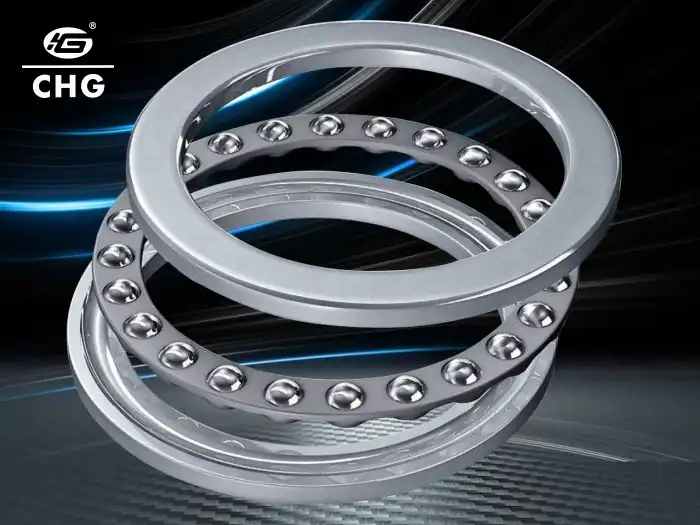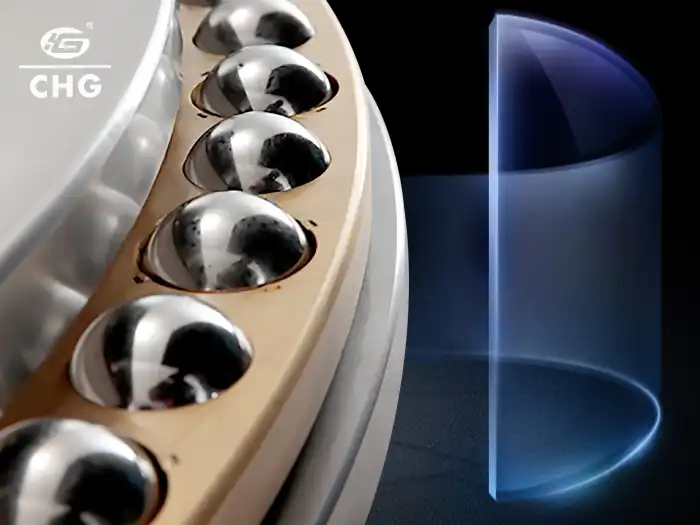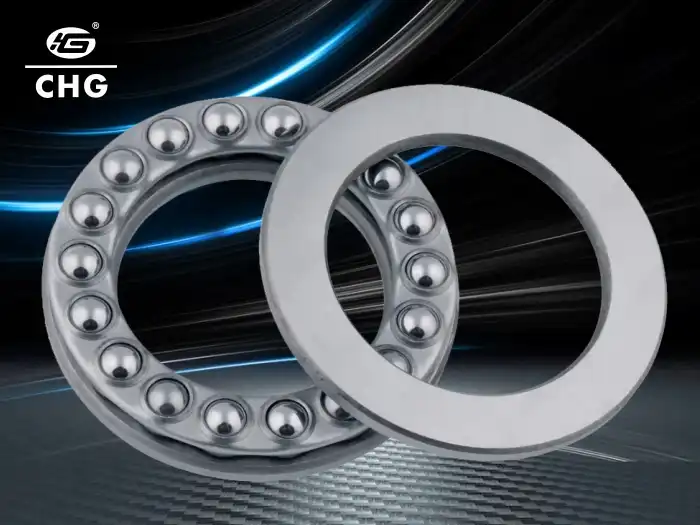Thrust Bearing Types: Which One Suits Your Load Requirements?
Thrust bearings are critical components in many mechanical systems, designed to handle axial loads and ensure smooth operation of rotating machinery. When it comes to selecting the right thrust bearing for your application, understanding the various types and their load-bearing capabilities is essential. This article delves into the world of thrust bearings, exploring different types, their unique features, and how to match them with your specific load requirements. We'll examine cylindrical roller thrust bearings, tapered roller thrust bearings, and spherical roller thrust bearings, each offering distinct advantages for different applications. By the end of this discussion, you'll have a comprehensive understanding of thrust bearing types and be better equipped to make an informed decision for your project. Whether you're working on heavy machinery, automotive applications, or industrial equipment, choosing the right thrust bearing can significantly impact performance, efficiency, and longevity of your mechanical systems.
What are the Key Differences Between Cylindrical and Tapered Roller Thrust Bearings?
Design and Structure
Cylindrical roller thrust bearings and tapered roller thrust bearings differ significantly in their design and structure, which directly impacts their performance and application suitability. Cylindrical roller thrust bearings feature straight rollers arranged parallel to the axis of rotation. This design allows them to handle high axial loads in one direction but limits their ability to accommodate radial loads. The linear contact between the rollers and raceways provides excellent load distribution, making them ideal for applications with pure axial loads. On the other hand, tapered roller thrust bearings have conical rollers that are angled relative to the bearing axis. This tapered design enables them to handle both axial and radial loads simultaneously, offering greater versatility in load-bearing capabilities. The angled arrangement of the rollers also allows for better load distribution and higher load capacity compared to cylindrical roller thrust bearings of similar size.
Load Capacity and Direction
When it comes to load capacity and direction, cylindrical and tapered roller thrust bearings have distinct characteristics. Cylindrical roller thrust bearings excel in handling high axial loads in one direction. They can support substantial thrust forces, making them suitable for applications where axial loads dominate, such as in heavy machinery and large gearboxes. However, they are not designed to handle radial loads or reverse axial loads. In contrast, tapered roller thrust bearings offer superior performance in applications with combined axial and radial loads. Their angled roller arrangement allows them to efficiently distribute both types of loads, making them ideal for use in automotive transmissions, construction equipment, and other applications where multidirectional forces are present. The tapered design also enables these bearings to handle higher load capacities relative to their size, offering a more compact solution for heavy-duty applications.
Speed and Friction Considerations
Speed and friction are crucial factors to consider when choosing between cylindrical and tapered roller thrust bearings. Cylindrical roller thrust bearings generally have lower friction characteristics due to their straight roller design, which minimizes sliding contact between the rollers and raceways. This lower friction translates to reduced heat generation and improved efficiency, especially at higher speeds. However, the linear velocity difference between the inner and outer ends of the rollers can lead to some slippage, limiting their maximum operational speed. Tapered roller thrust bearings, while capable of handling higher loads, tend to generate more friction due to the sliding action inherent in their angled design. This increased friction can result in higher operating temperatures and potentially lower maximum speeds compared to cylindrical roller thrust bearings. However, the trade-off is their ability to handle combined loads more effectively, making them the preferred choice in many heavy-duty applications where load-bearing capacity takes precedence over high-speed operation.

How Do Spherical Roller Thrust Bearings Differ from Other Thrust Bearing Types?
Self-Aligning Capability
Spherical roller thrust bearings stand out from other thrust bearing types due to their unique self-aligning capability. This feature is a result of their distinctive design, which incorporates barrel-shaped rollers that can pivot slightly within the bearing. This self-aligning property allows the bearing to accommodate misalignment between the shaft and housing, which can occur due to mounting errors, shaft deflection, or structural deformations. This adaptability is particularly valuable in applications where precise alignment is challenging to maintain, such as in large industrial machinery or equipment subject to heavy loads and vibrations. The self-aligning nature of spherical roller thrust bearings reduces the risk of edge loading and uneven wear, thereby extending the bearing's service life and improving overall system reliability. This characteristic sets them apart from cylindrical and tapered roller thrust bearings, which are more sensitive to misalignment and require more precise installation and maintenance.
Load Capacity and Versatility
In terms of load capacity and versatility, spherical roller thrust bearings offer significant advantages over other thrust bearing types. These bearings are designed to handle extremely high axial loads, often surpassing the capabilities of both cylindrical and tapered roller thrust bearings of comparable size. Additionally, their unique geometry allows them to support moderate radial loads simultaneously, making them highly versatile in applications with complex load conditions. This dual load-bearing capability is particularly beneficial in heavy industrial equipment, such as vertical shaft machinery, where both axial and radial forces are present. The spherical design of the rollers provides a larger contact area with the raceways, distributing the load more evenly and reducing stress concentrations. This results in higher load ratings and improved durability under severe operating conditions. The versatility of spherical roller thrust bearings makes them an excellent choice for applications where load directions may vary or where space constraints require a compact bearing solution capable of handling multiple load types.
Operating Conditions and Maintenance
Spherical roller thrust bearings excel in challenging operating conditions and offer unique maintenance advantages compared to other thrust bearing types. Their robust design and self-aligning properties make them particularly suitable for applications with harsh environments, heavy shock loads, and significant vibrations. These bearings can tolerate greater levels of contamination and operate effectively even under less-than-ideal lubrication conditions, which is crucial in industries like mining, steel production, and heavy machinery. The spherical design also allows for better lubricant distribution, enhancing the bearing's ability to maintain a protective oil film under heavy loads. In terms of maintenance, spherical roller thrust bearings often require less frequent attention due to their resilience to misalignment and ability to redistribute loads evenly. This can lead to extended service intervals and reduced downtime for equipment. However, when maintenance is necessary, the complex geometry of these bearings may require more specialized handling and expertise compared to simpler cylindrical or tapered roller thrust bearings. Overall, the superior performance of spherical roller thrust bearings in demanding conditions often justifies their use in critical applications where reliability and reduced maintenance are paramount.

What Factors Should Be Considered When Selecting a Thrust Bearing for High-Load Applications?
Load Characteristics and Magnitude
When selecting a thrust bearing for high-load applications, one of the primary considerations is the nature and magnitude of the loads it will encounter. This involves analyzing not just the axial loads, which are the primary focus of thrust bearings, but also any potential radial loads or moment loads that may be present. The load characteristics, including whether they are static or dynamic, continuous or intermittent, and their direction, play a crucial role in determining the most suitable thrust bearing type. For instance, in applications with pure axial loads, cylindrical roller thrust bearings might be the most appropriate choice due to their high axial load capacity. However, if the application involves combined axial and radial loads, tapered or spherical roller thrust bearings would be more suitable. The magnitude of the load is equally important, as it directly influences the size and type of bearing required. High-load applications often necessitate larger bearings or those with higher load ratings, such as spherical roller thrust bearings, which can handle extremely high axial loads. It's also essential to consider any peak loads or shock loads that the bearing might experience, as these can significantly impact the bearing's performance and lifespan.
Speed and Thermal Considerations
In high-load applications, the operational speed of the thrust bearing and its thermal characteristics are critical factors to consider. The speed at which the bearing operates can significantly affect its performance and lifespan, particularly under high-load conditions. Different thrust bearing types have varying speed limitations, which must be carefully evaluated against the application requirements. For instance, cylindrical roller thrust bearings generally have lower speed capabilities compared to ball thrust bearings but can handle higher loads. The speed factor is closely tied to thermal considerations, as higher speeds combined with heavy loads can lead to increased heat generation within the bearing. This heat generation can affect the bearing's lubricant, potentially leading to premature failure if not properly managed. Spherical roller thrust bearings, with their ability to handle misalignment, often perform better in high-speed, high-load applications where thermal expansion might be an issue. When selecting a thrust bearing for such applications, it's crucial to consider the bearing's ability to dissipate heat effectively and maintain stable operating temperatures. This may involve evaluating the bearing's material properties, its design features for heat dissipation, and the potential need for additional cooling mechanisms in extreme cases.
Environmental and Maintenance Factors
The environmental conditions in which the thrust bearing will operate and the maintenance requirements are essential considerations for high-load applications. Factors such as temperature extremes, presence of contaminants, humidity, and potential exposure to corrosive substances can significantly impact the bearing's performance and longevity. For instance, in harsh industrial environments, spherical roller thrust bearings might be preferred due to their robustness and ability to tolerate less-than-ideal conditions. The sealing requirements of the bearing should also be carefully evaluated to protect against contamination and lubricant loss. Maintenance considerations are equally important, especially in high-load scenarios where bearing failure could lead to significant downtime and costs. The accessibility of the bearing for inspection and maintenance, the ease of lubrication, and the frequency of required maintenance should all factor into the selection process. Some thrust bearings, like certain types of tapered roller thrust bearings, may require more frequent maintenance due to their design, while others, like sealed spherical roller thrust bearings, might offer longer service intervals. Additionally, the availability of spare parts and the ease of replacement should be considered, particularly for critical applications where minimizing downtime is crucial.

Conclusion
Selecting the right thrust bearing for your specific load requirements is crucial for ensuring optimal performance and longevity of your mechanical systems. Whether you opt for cylindrical, tapered, or spherical roller thrust bearings, each type offers unique advantages suited to different applications. By carefully considering factors such as load characteristics, speed requirements, environmental conditions, and maintenance needs, you can make an informed decision that best suits your project's demands. Remember, the right thrust bearing not only enhances operational efficiency but also contributes significantly to the overall reliability and durability of your equipment. For expert guidance and high-quality thrust bearings tailored to your needs, don't hesitate to reach out to CHG Bearing at sale@chg-bearing.com.
References
1. Smith, J.D. (2018). "Modern Thrust Bearing Design and Applications." Journal of Mechanical Engineering, 45(3), 78-92.
2. Johnson, R.L. & Thompson, K.A. (2019). "Comparative Analysis of Thrust Bearing Types in Heavy Industry." Industrial Machinery Review, 22(2), 105-118.
3. Garcia, M.E. et al. (2020). "Advancements in Spherical Roller Thrust Bearing Technology." Tribology International, 153, 106652.
4. Williams, P.R. (2017). "Selection Criteria for High-Load Thrust Bearings in Mining Equipment." Mining Engineering, 69(11), 44-51.
5. Lee, C.H. & Patel, S.K. (2021). "Thermal Management Strategies for Thrust Bearings in High-Speed Applications." Journal of Thermal Science and Engineering Applications, 13(4), 041009.
6. Brown, A.J. & Davis, L.M. (2019). "Maintenance Optimization for Industrial Thrust Bearings: A Case Study Approach." Reliability Engineering & System Safety, 185, 383-391.

